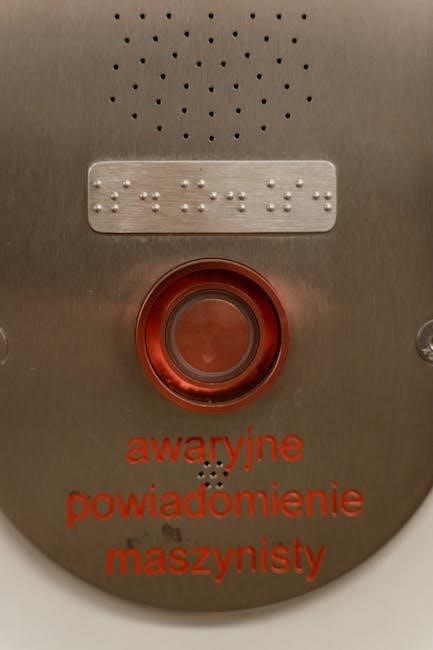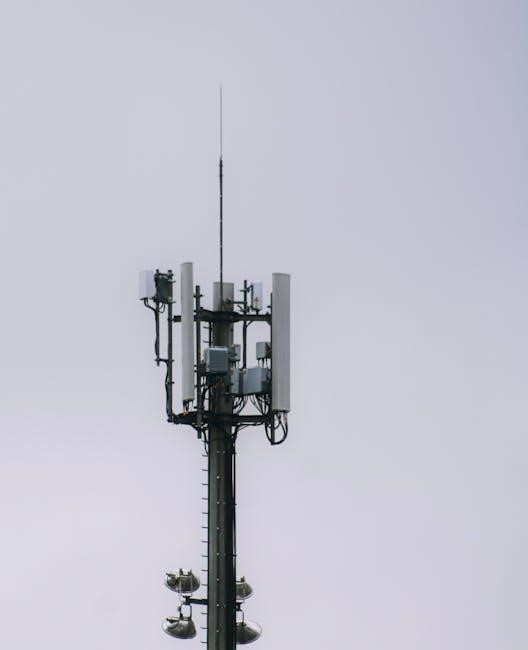signal operating instructions
Signal Operating Instructions (SOI) are standardized procedures governing military communication‚ ensuring secure and efficient signal transmission. They outline protocols for encoding‚ authenticating‚ and decrypting messages‚ critical for operational success.
Definition and Purpose of Signal Operating Instructions
Signal Operating Instructions (SOI)‚ also known as Communications-Electronics Operation Instructions (CEOI)‚ are detailed guidelines used by the U.S. military to standardize communication protocols. They define procedures for transmitting‚ receiving‚ and interpreting signals‚ ensuring clarity and security in military operations. The primary purpose of SOI is to establish a common framework for signal transmission‚ authentication‚ and encryption‚ minimizing errors and enhancing operational efficiency. These instructions are essential for maintaining consistent communication across units‚ ensuring that all personnel adhere to the same standards; By providing clear protocols‚ SOI enables secure and reliable exchange of critical information‚ which is vital for mission success. They also cover emergency signal protocols and the use of signal flags‚ ensuring preparedness for all scenarios. Overall‚ SOI plays a critical role in military communication‚ safeguarding operations and ensuring effective coordination.
Importance of Signal Operating Instructions in Military Communications
Signal Operating Instructions (SOI) are crucial for maintaining secure‚ efficient‚ and standardized communication in military operations. They ensure consistency across all units‚ reducing errors and misinterpretations. By providing clear protocols for signal transmission‚ authentication‚ and encryption‚ SOI enhances operational security and prevents unauthorized access. These instructions are vital for coordinating actions during combat‚ enabling precise and timely decision-making. They also cover emergency signal protocols‚ ensuring rapid response capabilities in critical situations. Additionally‚ SOI facilitates the use of signal flags and pennants‚ which are essential for visual communication in naval and ground operations. Their role extends to integrating modern technologies‚ such as encryption methods‚ to safeguard sensitive information. Overall‚ SOI is indispensable for ensuring reliable and secure communication‚ which is critical for mission success and national security. Their adherence is non-negotiable in maintaining operational effectiveness.
Historical Background of Signal Operating Instructions
Signal Operating Instructions (SOI) have their roots in early military communication systems‚ where standardized protocols were essential for coordination. The use of signal flags and pennants dates back centuries‚ providing visual communication methods for naval and ground forces. With the advent of radio communication in the early 20th century‚ the need for formalized signal protocols grew‚ leading to the development of SOI. These instructions were critical during World War I and II‚ ensuring secure and efficient transmission of messages. The U.S. military formalized SOI as a combat order‚ integrating encryption and authentication methods to prevent enemy interception. Over time‚ SOI evolved to incorporate advanced technologies‚ such as satellite communications and digital encryption‚ ensuring they remained relevant in modern warfare. Today‚ SOI continues to play a vital role in maintaining secure and standardized communication across military operations worldwide.

Key Components of Signal Operating Instructions

Signal Operating Instructions consist of encoded message formats‚ standardized encryption methods‚ and detailed procedures for transmission and authentication. They ensure secure and efficient communication across military units.
Types of Signals and Their Functions
Signal operating instructions define various types of signals‚ each serving specific purposes in military communications. These include command signals‚ which direct operations; status signals‚ which provide situational updates; and authentication signals‚ ensuring message legitimacy. There are also emergency signals for critical situations‚ navigation signals for directional guidance‚ and logistical signals for supply chain coordination. Each signal type is encoded with unique identifiers and protocols to prevent confusion or misinterpretation. Additionally‚ signals can be categorized as visual‚ auditory‚ or electronic‚ depending on the transmission method. Understanding these distinctions is crucial for effective communication‚ as each type plays a vital role in maintaining operational efficiency and security in military environments.
Standard Operating Procedures for Signal Transmission
Standard operating procedures (SOPs) for signal transmission are detailed guidelines ensuring reliable and secure communication. These procedures outline step-by-step processes for encoding‚ transmitting‚ and verifying signals. They include pre-transmission checks‚ such as equipment calibration and power level adjustments‚ to ensure optimal signal clarity. SOPs also specify protocols for signal authentication and encryption to prevent unauthorized access. Operators must adhere to designated frequency bands and transmission schedules to avoid interference. Post-transmission‚ procedures include signal acknowledgment and logging for record-keeping. These SOPs are critical for maintaining consistency‚ reducing errors‚ and ensuring compliance with security standards. Regular training and updates to SOPs are essential to adapt to evolving communication technologies and operational requirements. By following these procedures‚ military personnel can achieve efficient and secure signal transmission in diverse operational scenarios.
Authentication and Encryption Methods
Authentication and encryption are critical components of signal operating instructions‚ ensuring the integrity and confidentiality of communications. Authentication verifies the identity of the sender and the legitimacy of the signal‚ often using cryptographic protocols like digital signatures or one-time pads. Encryption methods‚ such as AES or RSA algorithms‚ scramble signals to prevent interception by unauthorized parties. These techniques are essential for safeguarding sensitive information‚ particularly in high-stakes military operations. Advanced encryption standards guarantee that even if a signal is intercepted‚ it cannot be deciphered without the proper decryption key. Regular updates to encryption protocols are vital to counter emerging cyber threats. By combining robust authentication and encryption‚ signal operating instructions ensure secure and reliable communication‚ minimizing the risk of data breaches or eavesdropping.
Emergency Signal Protocols
Emergency signal protocols are essential for maintaining communication during critical situations‚ ensuring rapid response and minimizing delays. These protocols often involve predefined signal formats‚ priority encoding‚ and standardized response procedures. In military contexts‚ emergency signals may include distress calls‚ urgent alerts‚ or situation reports‚ which are structured to convey critical information swiftly. Signal operating instructions outline specific frequencies‚ codes‚ or visual signals for emergencies‚ such as Mayday calls in naval operations or distress signals in aviation. These protocols also include redundancy measures‚ like backup communication channels‚ to ensure reliability. Training and drills are conducted to familiarize personnel with these procedures‚ enabling quick and decisive action during emergencies. The primary goal is to ensure seamless communication‚ even under adverse conditions‚ to protect lives and resources effectively.
Implementation and Use of Signal Operating Instructions
Signal operating instructions are implemented through standardized protocols‚ ensuring clear communication and operational efficiency; Proper training and adherence to procedures guarantee accurate signal transmission and interpretation‚ maintaining security and reliability in military operations. Regular reviews and updates ensure alignment with evolving communication needs and technological advancements. Effective implementation requires coordination across all units‚ fostering seamless integration into daily operations and critical missions; This systematic approach ensures signals are used appropriately‚ supporting strategic objectives and maintaining operational integrity. Continuous monitoring and feedback loops further refine processes‚ optimizing performance and adaptability in dynamic environments. The result is enhanced communication capabilities that are vital to achieving mission success.

Steps for Encoding and Transmitting Signals
Encoding and transmitting signals involve systematic steps to ensure accuracy and security. First‚ messages are prepared according to standardized formats‚ incorporating cryptographic protocols for encryption. Authentication codes are added to verify the sender’s identity and validate the signal. Once encoded‚ signals are transmitted through designated communication channels‚ such as radio‚ optical‚ or digital systems. Operators select appropriate frequencies and power levels to optimize signal strength and reach. Real-time monitoring ensures signal clarity and reception quality. Acknowledgment protocols confirm successful transmission‚ and logs are maintained for record-keeping. These steps ensure efficient‚ secure‚ and reliable communication‚ critical for military and operational success. Adherence to these procedures minimizes errors and enhances overall effectiveness in achieving communication objectives.
Procedures for Receiving and Decoding Signals
Receiving and decoding signals follow a structured process to ensure accuracy and security. Operators first tune receivers to the designated frequency‚ synchronizing with the transmitter. Signals are captured and stored for processing. Decryption methods‚ such as cryptographic keys or decoding algorithms‚ are applied to retrieve the original message. Signal strength and clarity are assessed to ensure reliable transmission. Authentication protocols verify the sender’s identity and message integrity. Once decoded‚ the message is reviewed for accuracy and relevance. Logs are maintained for record-keeping‚ and feedback mechanisms confirm successful receipt. Real-time verification ensures data integrity‚ while acknowledgment signals are sent to confirm reception. These procedures ensure secure‚ accurate‚ and efficient communication‚ maintaining operational effectiveness and security in military and critical systems. Proper execution of these steps is vital for reliable signal interpretation and response.
Use of Signal Flags and Pennants
Signal flags and pennants are essential visual communication tools in military and maritime operations. Flags are standardized to represent letters‚ numbers‚ or specific messages‚ enabling quick identification. Pennants‚ often smaller and simpler‚ signal status or commands. In naval contexts‚ flags are hoisted on masts or yards to convey messages between ships or shore. Colors and patterns ensure visibility even at a distance. Each flag corresponds to a unique meaning‚ and combinations can convey complex information. Training in flag etiquette ensures proper display and interpretation. Signals are used for operational commands‚ distress calls‚ or ceremonial purposes. Their use is governed by strict protocols to avoid miscommunication. Despite advancements in technology‚ signal flags remain reliable in low-tech or emergency scenarios‚ ensuring clear and instantaneous communication. Their historical significance and practicality make them enduring elements of signal operating instructions.
Integration with Modern Communication Systems
Signal operating instructions are increasingly integrated with modern communication systems to enhance efficiency and accuracy. This integration allows for seamless interaction between traditional signaling methods and advanced technologies like satellite communications‚ software-defined radios‚ and encrypted data networks. Modern systems incorporate signal protocols into digital platforms‚ enabling real-time monitoring and feedback. Automation tools streamline encoding and decoding processes‚ reducing human error. Cybersecurity measures are embedded to protect signals from interception or tampering. This fusion ensures that historical signaling practices remain relevant in contemporary operations. The combination of legacy methods with cutting-edge technology provides robust communication solutions for military and naval applications. Real-time data synchronization and cross-platform compatibility are critical benefits‚ ensuring reliable communication in diverse operational environments. This integration is vital for maintaining operational superiority in today’s fast-evolving military landscape.

Best Practices for Signal Operating Instructions
Adhere to established protocols‚ conduct regular training‚ and maintain equipment. Monitor signal accuracy and security in real-time to ensure reliable communication and operational success.
Adhering to Signal Security Protocols
Ensuring signal security is critical to prevent unauthorized access and maintain operational integrity. Use encryption methods like AES-256 for data protection and implement authentication protocols such as digital signatures. Regularly update cryptographic keys and verify signal sources to avoid spoofing. Establish secure communication channels using SSL/TLS protocols and limit access to sensitive information. Conduct periodic security audits to identify vulnerabilities and address them promptly. Train personnel on recognizing and reporting suspicious signals. Implement multi-factor authentication for critical systems and use secure coding practices to prevent interception. Real-time monitoring of signal traffic helps detect anomalies early. By adhering to these protocols‚ signals remain confidential‚ authentic‚ and resistant to cyber threats‚ ensuring reliable communication in military operations.
Regular Training and Drills
Regular training and drills are essential to maintain proficiency in signal operating instructions. These exercises ensure personnel are well-versed in encoding‚ transmitting‚ and decoding signals accurately. Simulated scenarios‚ such as communication blackouts or enemy interference‚ test readiness and decision-making under pressure. Hands-on drills reinforce proper use of equipment‚ adherence to protocols‚ and teamwork. Training sessions should include both routine operations and emergency procedures to prepare for all situations. Feedback from drills helps identify weaknesses and improve overall performance. By conducting these exercises frequently‚ military units ensure seamless communication‚ reduce errors‚ and enhance operational efficiency. Consistent training fosters confidence and readiness‚ enabling effective execution of signal operating instructions in real-world scenarios.
Equipment Maintenance and Calibration
Proper equipment maintenance and calibration are critical for ensuring reliable signal transmission and reception. Regular inspection of communication devices‚ such as transceivers and antennas‚ helps identify and address wear and tear. Calibration ensures that equipment operates within specified frequency and power parameters‚ minimizing interference. Cleaning connectors and replacing faulty components prevents signal degradation. Additionally‚ software updates and firmware checks are essential for maintaining compatibility with evolving signal operating instructions. Scheduling routine maintenance during low-activity periods reduces operational disruptions. Well-maintained equipment enhances signal clarity‚ reduces errors‚ and supports seamless communication. Regular calibration also ensures compliance with standardized protocols‚ guaranteeing interoperability across systems; By prioritizing equipment upkeep‚ military units can sustain high levels of operational readiness and effectiveness in critical situations.
Real-Time Monitoring and Feedback

Real-time monitoring and feedback are essential for maintaining the integrity and efficiency of signal operating instructions. Continuous surveillance of signal transmission ensures timely detection of errors or anomalies‚ allowing for immediate corrective actions. Automated systems track signal strength‚ latency‚ and data integrity‚ providing operators with actionable insights. Feedback loops enable rapid adjustments to signal parameters‚ such as frequency or encryption levels‚ to optimize performance. This capability is particularly critical in dynamic environments‚ where signal quality can fluctuate due to environmental factors or adversary actions. Real-time monitoring also enhances situational awareness‚ enabling better decision-making and coordination across units. By integrating monitoring tools with command systems‚ military personnel can respond swiftly to changing conditions‚ ensuring reliable communication and operational success. Regular feedback ensures that signal operating instructions remain effective and aligned with mission objectives.

Real-World Applications of Signal Operating Instructions
Signal operating instructions are crucial in military operations‚ ensuring reliable communication during combat‚ naval maneuvers‚ and joint exercises. They enhance coordination across branches‚ integrating with advanced technologies like AI and quantum systems to secure mission success and national security.
Use in Combat Operations
Signal operating instructions are vital in combat operations‚ ensuring secure and reliable communication for mission success. They provide standardized protocols for encoding‚ transmitting‚ and decoding messages‚ minimizing errors and delays. These instructions include authentication methods to prevent enemy interception and emergency signal protocols for critical situations. By adhering to these guidelines‚ military units maintain coordination and situational awareness‚ crucial for tactical decisions and troop safety. The structured communication enhances responsiveness‚ allowing forces to adapt swiftly to dynamic combat environments. Effective signal operating instructions are essential for executing strategies seamlessly‚ ensuring operational efficiency‚ and safeguarding personnel; Their role in combat underscores their importance in modern military tactics and national security.
Application in Naval Communications
Signal operating instructions play a critical role in naval communications‚ enabling clear and precise information exchange between ships and command centers. These instructions outline protocols for transmitting vital data‚ such as vessel positions‚ mission updates‚ and tactical maneuvers. Naval signals often involve the use of flag hoists‚ pennants‚ and electronic transmissions to ensure rapid communication. Authentication procedures are essential to verify the legitimacy of signals‚ preventing enemy deception. In maritime operations‚ signal operating instructions also cover emergency protocols‚ such as distress signals‚ to ensure timely assistance. The structured framework of these instructions enhances coordination among naval units‚ supporting effective command and control at sea. Their application is integral to maintaining situational awareness and operational success in naval missions.
Role in Air Force Operations
Signal operating instructions are vital in Air Force operations‚ ensuring seamless communication and coordination between aircraft‚ ground units‚ and command centers. These instructions dictate standardized protocols for transmitting mission-critical data‚ such as flight plans‚ target coordinates‚ and status updates. In airborne operations‚ signals are often encrypted to prevent interception‚ with authentication codes verifying the sender’s identity. Air Force personnel rely on these instructions to execute tactical maneuvers‚ such as formation flying or combat sorties‚ with precision. Emergency signal protocols are also defined to address situations like aircraft malfunctions or hostile engagement. By adhering to signal operating instructions‚ the Air Force maintains operational integrity‚ enabling swift decision-making and effective mission execution. Their role is pivotal in upholding air superiority and mission success in dynamic combat environments.
Use in Joint Military Exercises
Signal operating instructions are essential in joint military exercises‚ where coordination among multiple branches and allied forces is critical. These instructions ensure standardized communication protocols‚ enabling seamless interoperability between different military units. During exercises‚ signals are used to synchronize maneuvers‚ share intelligence‚ and execute tactical plans; Authentication and encryption methods prevent unauthorized access‚ while emergency protocols address unexpected scenarios. Joint exercises test the effectiveness of signal operating instructions in real-world scenarios‚ fostering collaboration and improving response times. By adhering to these guidelines‚ participating forces maintain operational cohesion‚ enhance readiness‚ and strengthen strategic partnerships. The role of signal operating instructions in joint exercises is vital for achieving mission success and ensuring effective teamwork across diverse military organizations.

Future Trends in Signal Operating Instructions
Future trends in signal operating instructions involve integrating quantum communication for enhanced security‚ leveraging AI for optimized processing‚ and adopting autonomous systems for efficient real-time operations.
Integration with Artificial Intelligence
The integration of artificial intelligence (AI) into signal operating instructions is revolutionizing military communications. AI algorithms can analyze vast amounts of data to optimize signal transmission‚ reducing errors and enhancing speed. Machine learning enables systems to adapt to evolving threats‚ improving signal security and reliability. Automated decision-making capabilities allow AI to prioritize signals‚ ensuring critical information reaches its destination swiftly. Natural Language Processing (NLP) enhances communication clarity‚ while predictive analytics anticipate potential disruptions. AI-driven systems also enable real-time monitoring and feedback‚ improving overall efficiency. Despite these advancements‚ challenges like cybersecurity and ethical concerns must be addressed. As AI continues to evolve‚ its role in signal operations will expand‚ making it a cornerstone of future military communication systems.
Use of Quantum Communication Technologies

Quantum communication technologies are revolutionizing signal operating instructions by offering unparalleled security and speed. These technologies leverage quantum mechanics‚ such as quantum entanglement‚ to enable ultra-secure data transmission. Quantum key distribution (QKD) ensures that any attempt to intercept signals is detectable‚ safeguarding sensitive information. Quantum communications also promise faster processing of complex signals‚ enhancing real-time decision-making in military operations. However‚ challenges remain‚ including the sensitivity of quantum systems to environmental interference and the need for specialized infrastructure. Despite these hurdles‚ the integration of quantum technologies into signal operating instructions could enable next-generation communication systems with unmatched reliability and security‚ making them indispensable for future military operations and strategic communications.
Enhanced Encryption and Security Measures
Enhanced encryption and security measures are critical components of modern signal operating instructions‚ ensuring the integrity and confidentiality of communications. Advanced encryption algorithms‚ such as AES-256 and quantum-resistant protocols‚ are being integrated to safeguard signals from unauthorized access. Multi-layered security protocols‚ including end-to-end encryption and secure key exchange‚ further protect data transmission. Role-based access control and biometric authentication are also being implemented to restrict signal handling to authorized personnel. Regular security audits and vulnerability assessments are conducted to identify and mitigate potential risks. These measures ensure that signal operating instructions remain resilient against evolving cyber threats‚ maintaining operational security and trust in military and strategic communications systems.
Adoption of Autonomous Signal Systems

The adoption of autonomous signal systems represents a significant advancement in signal operating instructions‚ enabling real-time processing and decision-making without human intervention. These systems leverage artificial intelligence and machine learning to analyze patterns‚ optimize signal transmission‚ and adapt to dynamic environments. Autonomous signal systems enhance reliability by minimizing human error and ensuring consistent protocol adherence. They are particularly valuable in high-stress scenarios‚ where rapid decision-making is critical. Advanced algorithms enable these systems to prioritize signals‚ manage bandwidth‚ and maintain communication continuity. While autonomous systems reduce the need for manual oversight‚ they still require periodic human review to ensure accuracy and alignment with operational goals. The integration of autonomous signal systems into modern communication infrastructure is revolutionizing military and strategic operations‚ promising greater efficiency and responsiveness in future missions.